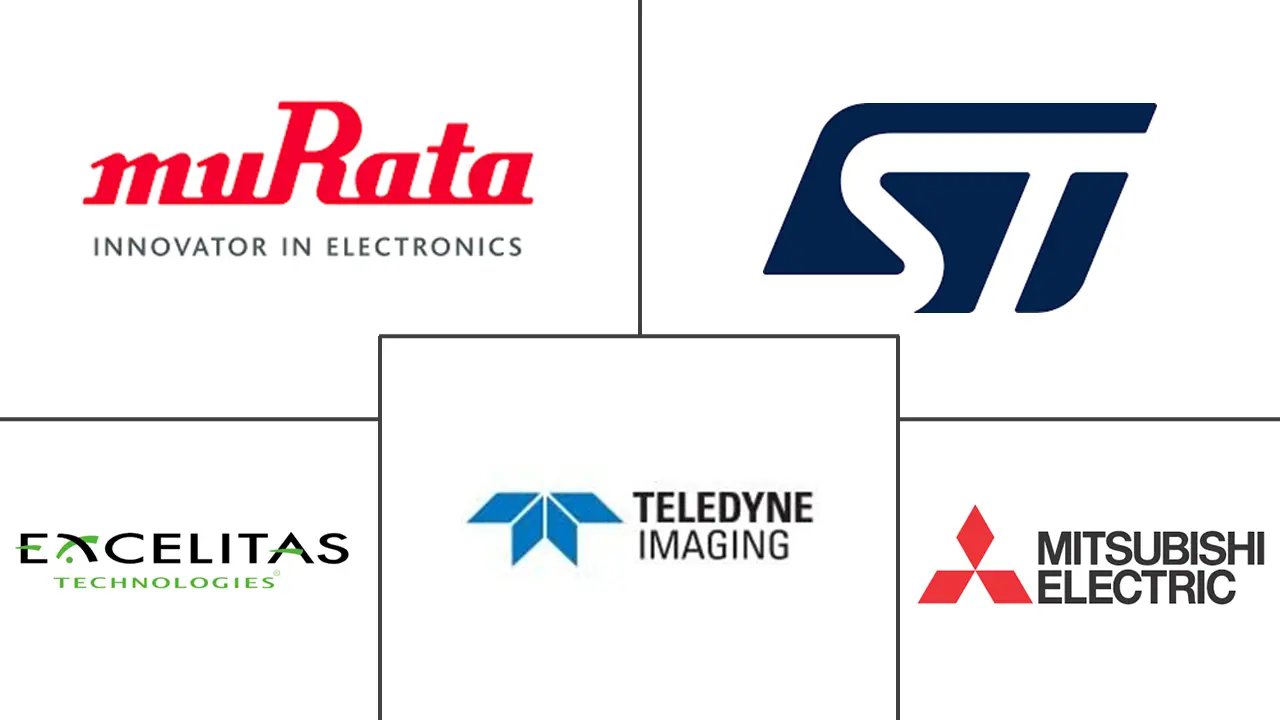Infrared Sensor Market Size and Share
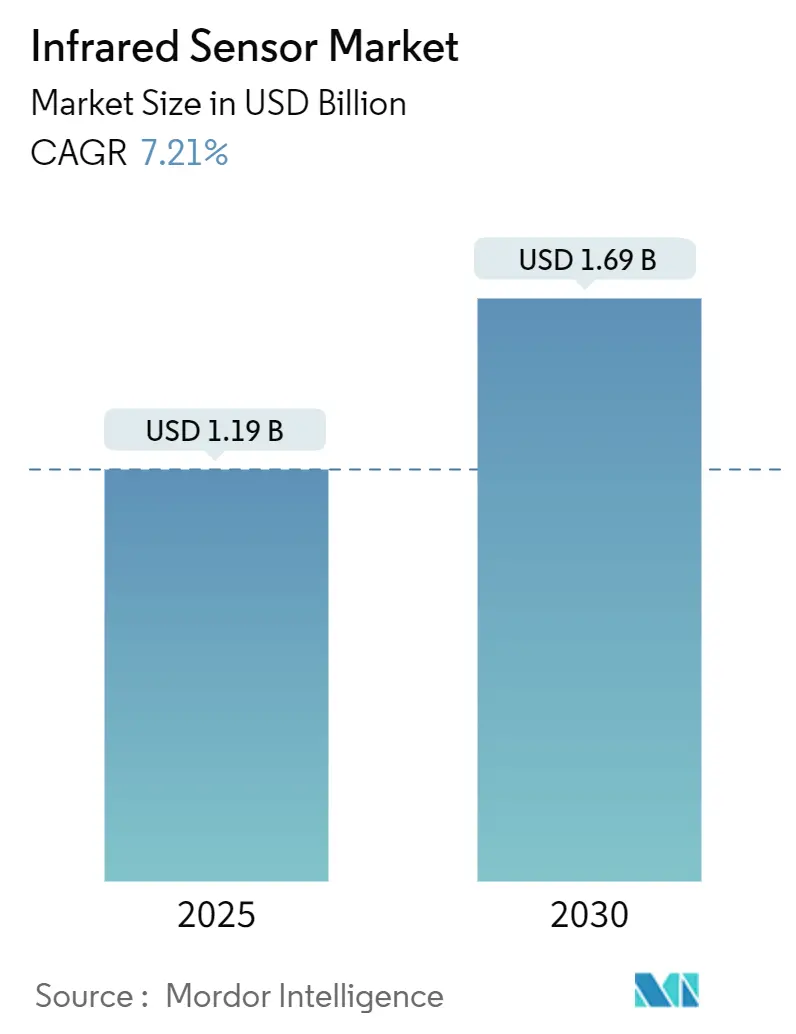
Infrared Sensor Market Analysis by Mordor Intelligence
The Infrared Sensor Market size is estimated at USD 1.19 billion in 2025, and is expected to reach USD 1.69 billion by 2030, at a CAGR of 7.21% during the forecast period (2025-2030). The expansion is underpinned by rising Industry 4.0 automation projects, stricter automotive safety mandates, and material-level breakthroughs that improve detector sensitivity and cost efficiency. Near-infrared (NIR) devices remain the revenue cornerstone, yet far-infrared (FIR) arrays are moving fastest as thermal imaging proliferates in automotive, industrial, and medical settings. Packaging innovation chiefly wafer-level vacuum techniques, continues to compress bill-of-materials costs, while AI-enabled on-chip processing reshapes design priorities toward power-aware, event-driven architectures. Incremental gains in quantum efficiency, pixel pitch, and dynamic range are translating into new opportunities in predictive maintenance, gas monitoring, and adaptive driver assistance, thereby sharpening competition among established semiconductor houses and agile materials specialists.
Key Report Takeaways
- By type, NIR sensors led with 38% of infrared sensor market share in 2024; FIR devices are forecast to log the fastest 7.5% CAGR through 2030.
- By working mechanism, passive sensors led with 62% of the infrared sensor market size in 2024, whereas active sensors are set to advance at a 7.8% CAGR to 2030.
- By application, motion sensing contributed 32.4% of the infrared sensor market share in 2024; spectroscopy is advancing at an 8.0% CAGR through 2030.
- By end-user industry, aerospace and defense captured 28% revenue share in 2024, while healthcare is advancing at a 7.9% CAGR to 2030.
- By geography, North America accounted for 32% of the infrared sensor market size in 2024 and Asia-Pacific is expanding at an 8.2% CAGR through 2030.
Global Infrared Sensor Market Trends and Insights
Drivers Impact Analysis
| Driver | (~) % Impact on CAGR Forecast | Geographic Relevance | Impact Timeline |
|---|---|---|---|
| Surging adoption of Industry 4.0 automation | +1.2% | Global with APAC leadership | Medium term (2-4 years) |
| Expanding smart-home and consumer electronics base | +1.8% | North America and EU, expanding to APAC | Short term (≤ 2 years) |
| Rising demand from ADAS and autonomous vehicles | +2.1% | Global; early gains in North America, EU, China | Medium term (2-4 years) |
| Stricter safety and environmental regulations driving gas monitoring | +0.9% | Global with North America and EU focus | Long term (≥ 4 years) |
| Wafer-level vacuum packaging cutting IR sensor costs | +0.8% | Global manufacturing hubs, mainly APAC | Short term (≤ 2 years) |
| On-chip AI enabling ultra-low-power event-driven sensing | +0.6% | Global with R&D lead in North America and EU | Long term (≥ 4 years) |
| Source: Mordor Intelligence | |||
Surging Adoption of Industry 4.0 Automation
Thermal cameras, embedded in predictive-maintenance frameworks, now reduce unplanned downtime by 53% while maintaining high image fidelity, thereby accelerating payback periods for factory retrofits. Dual-sensor nodes that merge infrared thermography with acoustic emission enable anomaly detection in additive-manufacturing furnaces and rolling mills. Deployments increasingly exploit thermoelectric harvesters to power maintenance-free IIoT nodes that cut battery waste 94% and shrink total sensing cost 70%. [1]Demirhan Aydin et al., “Wafer Level Vacuum Packaging of MEMS-Based Uncooled Infrared Sensors,” Micromachines, Aug 10 2024, mdpi.com Transformer-based predictive models are achieving 99% identification accuracy for equipment health, making infrared data a trusted input for AI-driven maintenance schedules. Together, these advances embed the infrared sensor market more deeply in industrial value chains, driving volume growth even in low-margin plant retrofits.
Expanding Smart-Home and Consumer Electronics Base
Packaging advances allow TMOS-based presence sensors to detect humans four meters away without bulky concentrators, pushing infrared sensing into battery-powered smart thermostats and gesture-controlled appliances. [2]Editorial Team, “TMOS-Based Infrared Sensor Opens Up New Applications,” Electronic Specifier, Nov 18 2025, electronicspecifier.comMulti-zone time-of-flight ranging now extends daytime detection from 170 cm to 285 cm while cutting power from 4.5 mW to 1.6 mW, an efficiency leap critical for wearables and smart speakers.[3]STMicroelectronics Press, “ST’s Latest 8×8 Multi-Zone ToF Ranging Sensor Boosts Ambient-Light Immunity,” Semiconductor Today, Dec 22 2023, semiconductor-today.com Lead-free quantum-dot photodiodes deliver SWIR imaging at 1,390 nm, meeting environmental directives and enabling secure face authentication behind OLED displays. [4]Imec News Desk, “Imec and Partners Unveil SWIR Sensor With Lead-Free Quantum Dot Photodiodes,” LEDinside, Dec 24 2024, ledinside.comFlexible photothermoelectric films, sensitive to 0.05 °C changes, underpin emerging electronic-skin and AR-haptics categories. These innovations cement consumer electronics as an enduring demand engine for the infrared sensor market.
Rising Demand from ADAS and Autonomous Vehicles
Regulators in the United States and Europe are finalizing mandates for pedestrian automatic emergency braking, compelling OEMs to integrate long-wave infrared cameras into every new vehicle within five years. The automotive infrared camera sub-segment is predicted to reach USD 5 billion by 2035 as multi-spectral suites combine NIR for driver monitoring, SWIR for low-light scene enhancement, and LWIR for obstacle detection. YOLOv5-based perception stacks paired with thermal imagers are outperforming solely visible-light systems under rain and fog, raising OEM confidence in hybrid vision architectures. As cost curves decline, every incremental feature, from drowsiness detection to animal-avoidance, reinforces the infrared sensor market’s automotive momentum.
Stricter Safety and Environmental Regulations Driving Gas Monitoring
The U.S. Environmental Protection Agency now mandates optical-gas-imaging-enabled leak-detection programs, driving refinery and petrochemical facilities to deploy LWIR cameras in continuous monitoring roles. FLIR and BP pilots have demonstrated tighter methane control and injury-risk reduction. Research prototypes are lowering uncooled spectroscopy detection limits for SF₆, ethylene, and ammonia by as much as 67% through adaptive temperature-prediction algorithms. Governments across Europe are drafting similar leak-detection codes, solidifying environmental monitoring as an enduring growth pocket for the infrared sensor market.
Restraints Impact Analysis
| Restraint | (~) % Impact on CAGR Forecast | Geographic Relevance | Impact Timeline |
|---|---|---|---|
| High cost and cryogenic cooling of cooled IR detectors | -1.4% | Global; higher impact in cost-sensitive markets | Medium term (2-4 years) |
| Temperature-drift induced recalibration overheads | -0.8% | Global; acute in precision roles | Short term (≤ 2 years) |
| Supply bottlenecks for IR-grade compound semiconductors | -1.1% | Global with APAC concentration | Medium term (2-4 years) |
| Export-control restrictions on LWIR technologies | -0.6% | Primarily US-China trade; global spillover | Long term (≥ 4 years) |
| Source: Mordor Intelligence | |||
High Cost and Cryogenic Cooling of Cooled IR Detectors
Cooled detector assemblies impose significant capital and operating expense because Stirling engines or Joule–Thomson coolers must maintain cryogenic set-points for photon noise suppression. Even advances in multi-stage thermoelectric modules have not yet closed the cost gap against uncooled microbolometers, restraining adoption in mass-volume consumer and building-automation niches where price elasticity is high.
Temperature-Drift Induced Recalibration Overheads
LWIR arrays drift 16 mK for each 1 °C ambient swing, forcing frequent field calibration and driving total cost of ownership upward. Dual-blackbody benches can cut uniformity error 85.4% but require capital-intensive infrastructure and skilled personnel. Although adaptive weighted correction algorithms boost SNR, they increase firmware complexity and processing latency, slowing adoption in low-cost mobile platforms.
Segment Analysis
By Type: NIR Dominance Meets FIR Innovation
Near-infrared modules held 38% of overall infrared sensor market share in 2024, largely because silicon-based photodiodes and CMOS-ToF chips align with consumer-electronics cost curves. Quantum-dot SWIR prototypes from STMicroelectronics, featuring 1.62 µm pixel pitch and 60% quantum efficiency, promise single-digit-dollar dies that could swing incremental value toward higher-margin spectral bands. Meanwhile, carbon-nanotube imagers from NEC triple sensitivity at room temperature, creating an uncooled path to performance once reserved for HgCdTe focal-plane arrays. The FIR subset, buoyed by rapid thermal-imaging uptake, is tracking a 7.5% CAGR and is on course to narrow the revenue gap by the decade’s close.
Manufacturers are fielding hybrid modules that fuse NIR and FIR into a single optical train, easing camera alignment and broadening scene understanding in mobile robotics. Such dual-band platforms deepen the infrared sensor market size for value-added analytics, particularly where ambient-light variability or smoke obscuration challenges RGB-only vision.
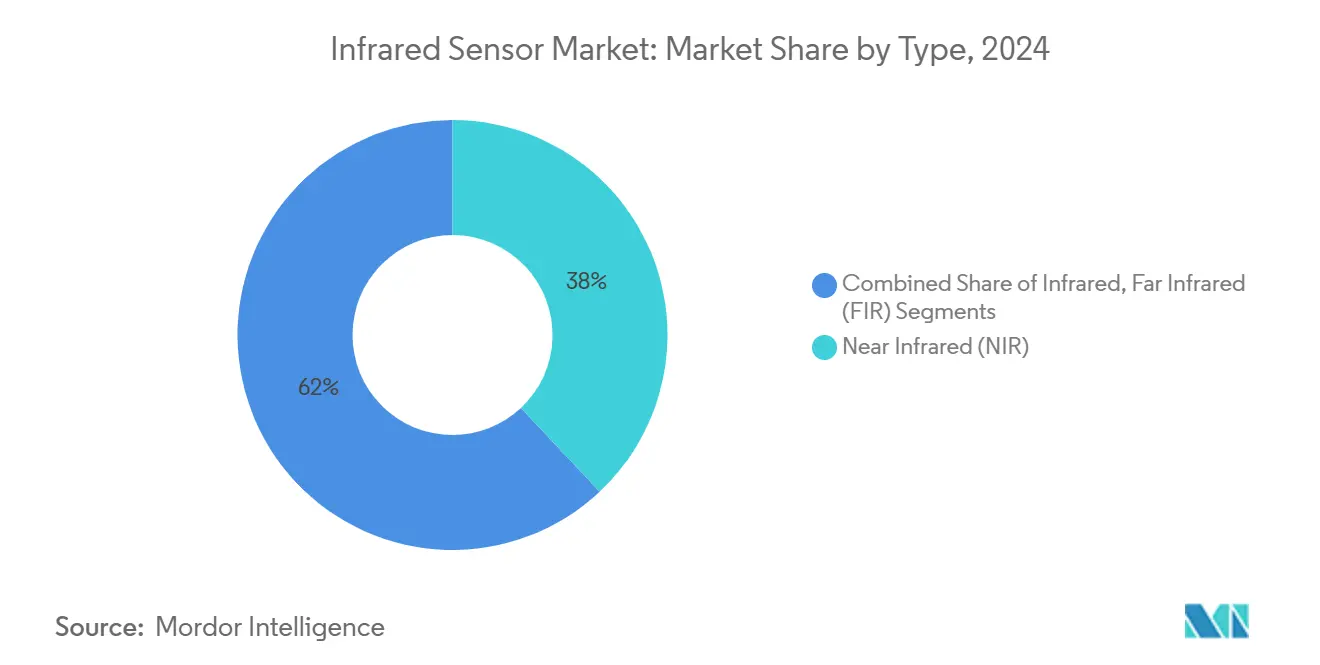
Note: Segment shares of all individual segments available upon report purchase
By Working Mechanism: Passive Sensors Lead Active Growth
Passive infrared maintained a 62% hold on the infrared sensor market size during 2024 owing to its milliwatt-level power draw, which makes it indispensable in battery-powered smart-home nodes. The global roll-out of energy-code-mandated occupancy sensors in new commercial buildings has cemented demand, with California Title 24 revisions alone driving tens of millions of yearly unit sales. Conversely, active infrared is slated for a 7.8% CAGR through 2030, fueled by LiDAR-adjacent applications that exploit modulated beams for depth perception in indoor robotics and AGVs. Low-cost vertical-cavity surface-emitting lasers (VCSELs) at 850 nm and 940 nm now pair with single-photon avalanche diodes on the same PCB, enabling centimeter-grade ranging up to 15 m in broad daylight. Dual-technology detectors combining passive motion triggers with active verification pulses are gaining popularity in commercial security where false alarm rates have direct insurance cost implications.
Regulatory pressure to cut standby energy use below 0.5 W in consumer electronics favors passive architectures, but the drive for gesture recognition and human-machine interaction in infotainment systems is tipping automakers toward active NIR arrays. The eventual convergence is likely to see software-defined sensors that dynamically toggle between passive and active modes based on ambient conditions and battery state.
By Application: Motion Sensing Stability Versus Spectroscopy Expansion
Motion sensing held a 32.4% slice of 2024 revenue, its endurance rooted in decades-old algorithms that detect differential heat against background scenes. Price elasticity remains high; unit ASPs have dropped to cents, allowing OEMs to blanket spaces with multi-node grids that feed building-management analytics. In contrast, spectroscopy’s 8.0% CAGR signals a shift toward higher-value analytical instruments. Pharmaceutical clean-rooms rely on NIR absorption spectra to validate active-ingredient concentrations in-line, slashing batch-release times from days to minutes. Environmental agencies deploy portable FTIR analysers to audit factory smokestacks in the field, trimming lab backlog and improving compliance enforcement velocity. Emerging micro-spectrometers built on integrated photonics platforms now fit inside a smartphone, opening consumer markets such as food freshness scanning.
Temperature measurement segments continue to serve industrial process control, with molten-steel casting lines and glass furnaces requiring non-contact pyrometers that operate above 1,200 °C. Gas and fire detection applications ride legislative momentum as municipalities adopt stricter building codes mandating continuous air-toxicity surveillance, spurring retrofits in high-rise ventilation shafts worldwide.
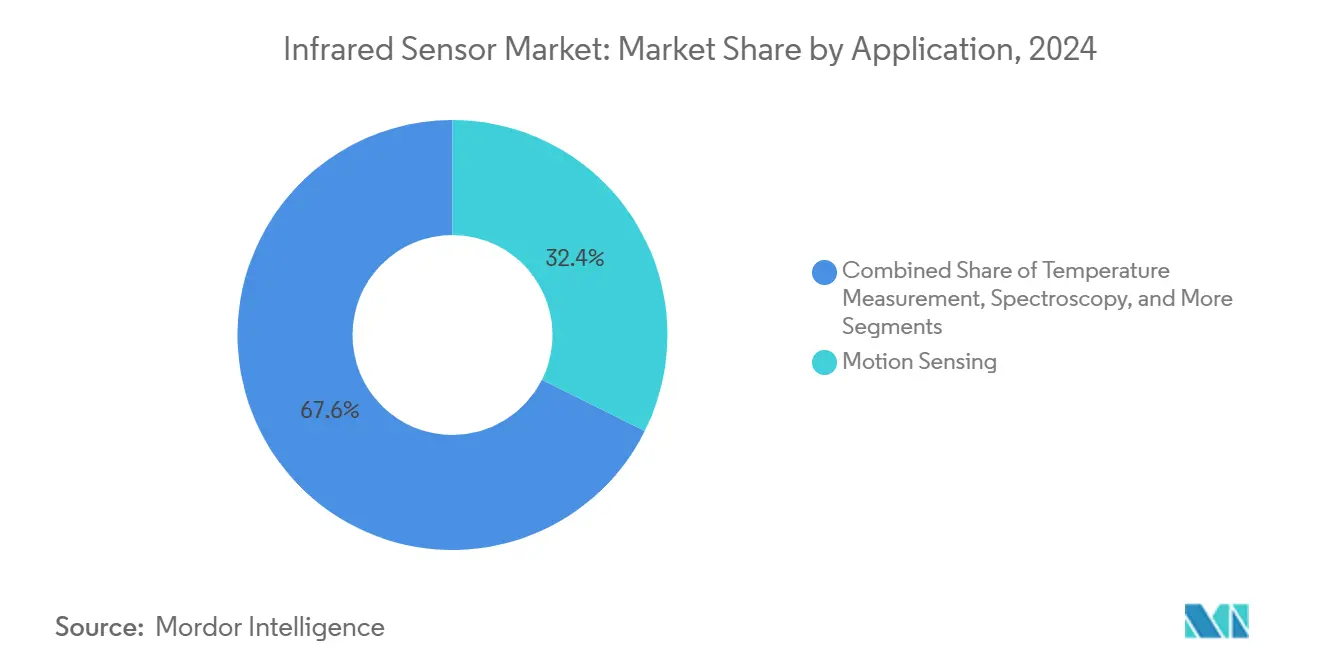
Note: Segment shares of all individual segments available upon report purchase
By End-User Industry: Defense Leadership Yields to Healthcare Growth
Defense procurement cycles sustained a 28% revenue share in 2024 but future gains moderate as budgets plateau. Conversely, hospital investment in non-invasive diagnostic imaging is spurring a 7.9% CAGR, raising healthcare’s slice of the infrared sensor market size each year. Non-contact fever-screening kiosks, bolstered by pandemic legacy protocols, continue to move from public venues into clinics and elder-care facilities. The automotive sector, already a USD 500 million opportunity for LWIR modules in 2024, accelerates as ADAS fit-rates climb toward universal inclusion in premium trims. Industry insiders expect healthcare spending momentum to surpass defense allocations by 2028 if reimbursement codes for thermography stabilize in major insurance markets.
Industrial manufacturing remains a steady adopter through predictive-maintenance retrofits, with infrared sensor market share fragmented across hundreds of OEMs delivering sector-specific solutions. Oil-and-gas customers sustain demand for mid-wave imagers to meet evolving greenhouse-gas detection mandates.
Geography Analysis
North America captured 32% of 2024 revenue on the back of entrenched aerospace suppliers, a robust automotive safety framework, and active smart-manufacturing incentives. Federal grants directed at semiconductor reshoring further encourage domestic wafer capacity additions, lowering geopolitical risk for local downstream camera makers. Europe follows with strong automotive tier-1 integration and industrial-automation depth; however, slower consumer-electronics growth moderates total expansion relative to Asia-Pacific.
The Asia-Pacific infrared sensor market is tracking an 8.2% CAGR, supported by volume smartphone production, aggressive smart-city rollouts, and policy-backed automation upgrades. China’s germanium export quotas sparked regional investment in alternative optical materials, catalyzing local ecosystem diversification. Japan maintains technology leadership via firms such as NEC and Hamamatsu that continually push detector physics boundaries, while South Korea leverages advanced packaging prowess to supply microbolometers for consumer drones and security cameras.
Emerging Middle East and Africa markets are beginning to trial thermal cameras for border security and power-plant safety, with funding often sourced from sovereign-wealth initiatives. Latin America demonstrates gradual traction in mining and agricultural automation; pilot programs deploying infrared-enabled drones for crop-health surveys show promising ROI but remain sensitive to currency volatility and import tariffs.
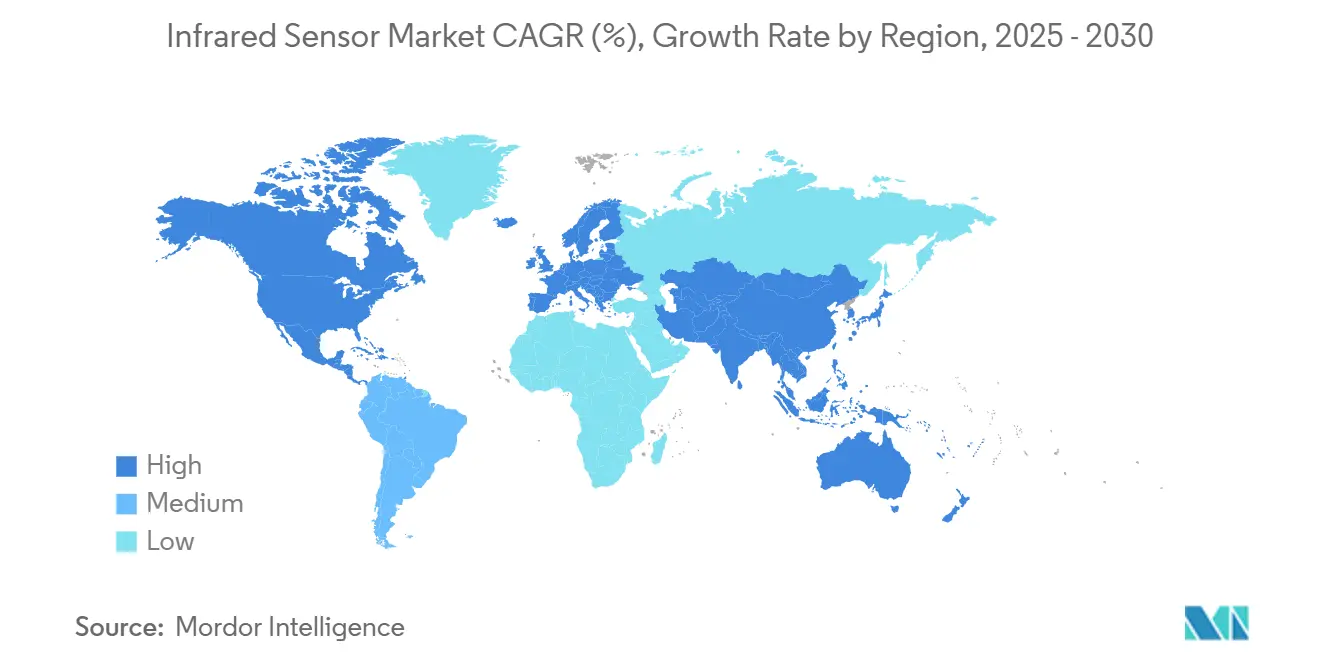
Competitive Landscape
Competitive intensity in the infrared sensor market is moderate, with incumbents such as STMicroelectronics, Teledyne, and Hamamatsu vying alongside agile innovators like NEC and TriEye. Strategic direction concentrates on three axes such as cost disruption via wafer-level vacuum packaging and stacked-die architectures that align bill-of-materials with consumer-tier price points. Material innovation, quantum dots, chalcogenide glasses, carbon nanotubes, that de-risk supply chains and elevate quantum efficiency. Function integration, embedding AI accelerators and analog front-ends within the same package to minimize latency and power.
Partnerships between CMOS foundries and optics firms are proliferating to close design-for-manufacture gaps. Patent filings in thermoelectric detector stacks and flexible substrate integration rose 18% in 2024, signaling an arms race in novel form factors. While top suppliers retain scale advantages, niche specialists focusing on high-value verticals, medical, gas-sensing, and space—continue to command premium gross margins.
Infrared Sensor Industry Leaders
-
Murata Manufacturing Co. Ltd
-
STMicroelectronics NV
-
Excelitas Technologies
-
Teledyne Imaging Inc.
-
Mitsubishi Electric Corporation
- *Disclaimer: Major Players sorted in no particular order
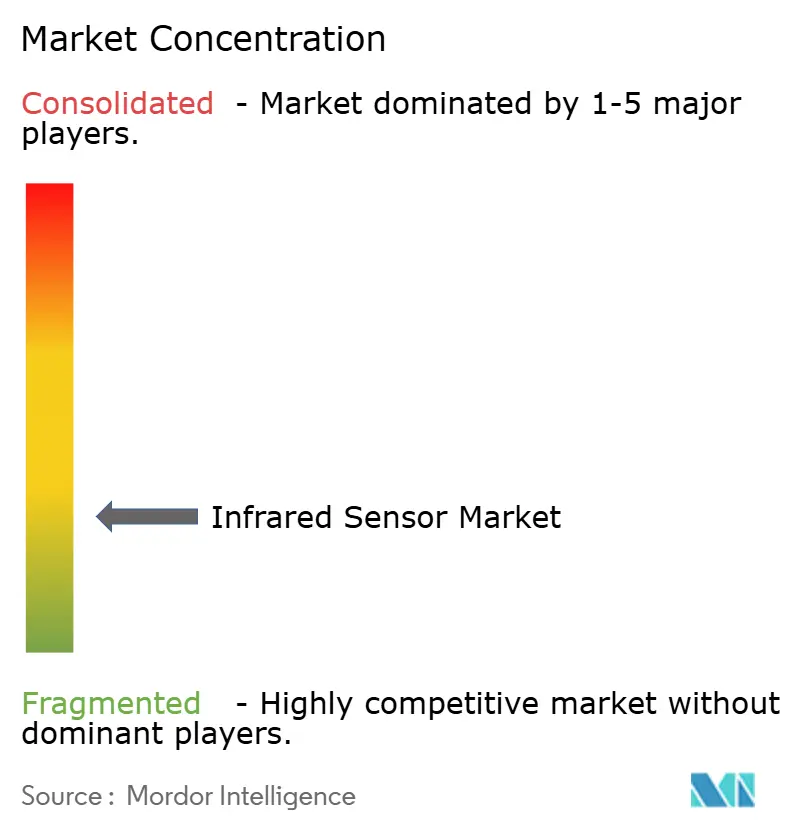
Recent Industry Developments
- April 2025: Melexis launched MLX90642, a 32×24-pixel array with 65 mK NETD at 2 Hz, targeting smart cooking and HVAC controls. The on-die microcontroller eliminates external processing, reinforcing the strategy to simplify integration for low-cost appliance makers.
- March 2025: Teledyne e2v introduced Lince5M, a 5.2-MP NIR CMOS sensor operating at 250 fps and 35% QE at 850 nm, positioning the firm for high-speed motion-capture and industrial metrology roles.
- February 2025: Hamamatsu rolled out G1719X InGaAs photodiodes in ceramic packages spanning 1.7–2.6 µm, reflecting a push toward compact gas-sensor modules for environmental compliance devices.
- December 2024: Imec unveiled a prototype SWIR imager with lead-free quantum-dot photodiodes, signaling environmental compliance leadership and a route to cost-effective SWIR smartphones.
- October 2024: TriEye and HLJ Technology announced a joint SWIR sensing platform that marries CMOS-based imagers with 1,135 nm VCSELs, pursuing volume entry into consumer cameras and industrial machine vision.
Global Infrared Sensor Market Report Scope
Infrared sensor instruments detect or emit infrared radiation to sense specific characteristics of their surroundings. These electronic detectors can detect motion and measure the heat emitted by objects. Thanks to technological advancements, infrared sensors are now lighter, more affordable, and have improved power efficiency. The market is defined by the revenue generated through the sales of different types of infrared sensors by major market vendors globally.
The infrared (IR) sensor market is segmented by type (near-infrared (NIR), infrared, and far infrared (FIR)), end-user industry (healthcare, aerospace and defense, automotive, commercial applications, manufacturing, oil, and gas, and other end-user industries), and geography (North America, Europe, Asia-Pacific, Latin America, Middle East and Africa). The market sizes and forecasts are provided in terms of value USD for all the above segments.
| Near Infrared (NIR) |
| Infrared |
| Far Infrared (FIR) |
| Active |
| Passive |
| Motion Sensing |
| Temperature Measurement |
| Security and Surveillance |
| Gas and Fire Detection |
| Spectroscopy |
| Other Applications |
| Healthcare |
| Aerospace and Defense |
| Automotive |
| Commercial Applications |
| Manufacturing |
| Oil and Gas |
| Other End-user Industries |
| North America | United States | |
| Canada | ||
| Mexico | ||
| South America | Brazil | |
| Argentina | ||
| Rest of South America | ||
| Europe | Germany | |
| United Kingdom | ||
| France | ||
| Italy | ||
| Spain | ||
| Rest of Europe | ||
| Asia Pacific | China | |
| Japan | ||
| India | ||
| South Korea | ||
| ASEAN | ||
| Rest of Asia Pacific | ||
| Middle East and Africa | Middle East | Saudi Arabia |
| United Arab Emirates | ||
| Rest of Middle East | ||
| Africa | South Africa | |
| Egypt | ||
| Rest of Africa | ||
| By Type | Near Infrared (NIR) | ||
| Infrared | |||
| Far Infrared (FIR) | |||
| By Working Mechanism | Active | ||
| Passive | |||
| By Application | Motion Sensing | ||
| Temperature Measurement | |||
| Security and Surveillance | |||
| Gas and Fire Detection | |||
| Spectroscopy | |||
| Other Applications | |||
| By End-user Industry | Healthcare | ||
| Aerospace and Defense | |||
| Automotive | |||
| Commercial Applications | |||
| Manufacturing | |||
| Oil and Gas | |||
| Other End-user Industries | |||
| By Geography | North America | United States | |
| Canada | |||
| Mexico | |||
| South America | Brazil | ||
| Argentina | |||
| Rest of South America | |||
| Europe | Germany | ||
| United Kingdom | |||
| France | |||
| Italy | |||
| Spain | |||
| Rest of Europe | |||
| Asia Pacific | China | ||
| Japan | |||
| India | |||
| South Korea | |||
| ASEAN | |||
| Rest of Asia Pacific | |||
| Middle East and Africa | Middle East | Saudi Arabia | |
| United Arab Emirates | |||
| Rest of Middle East | |||
| Africa | South Africa | ||
| Egypt | |||
| Rest of Africa | |||
Key Questions Answered in the Report
How fast is the infrared sensor market expected to grow through 2030?
The infrared sensor market is projected to expand from USD 1.10 billion in 2024 to USD 1.69 billion by 2030 at a 7.21% CAGR.
Which spectral band currently generates the most revenue?
Near-infrared devices dominate with 38% revenue share owing to mature silicon processes and high-volume consumer-electronics demand.
What end-user segment is expanding quickest?
Healthcare applications are posting the fastest 7.9% CAGR, fueled by medical imaging, diagnostic thermography, and fever-screening rollouts.
Which geographic region offers the strongest growth outlook?
Asia-Pacific is forecast to rise at an 8.2% CAGR as manufacturing automation, smart-city investment, and consumer-electronics output accelerate.
How are costs trending for thermal imaging modules?
Wafer-level vacuum packaging and stacked-die integration are cutting module costs up to 5×, paving the way for sub-USD 40 consumer-grade thermal cameras.
What materials innovation could shift competitive dynamics?
Quantum-dot photodiodes, carbon-nanotube detectors, and chalcogenide optics promise higher quantum efficiency and reduced dependence on restricted compounds.
Page last updated on:
